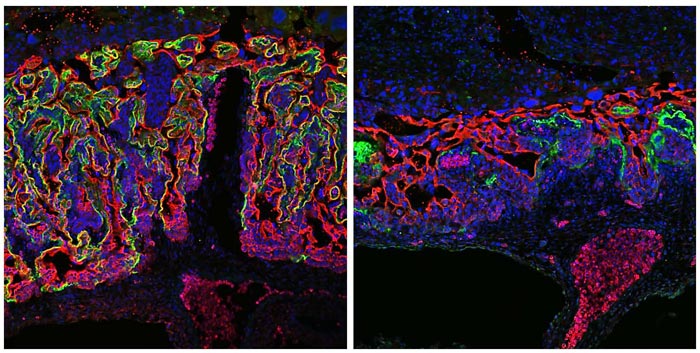MDC Researchers Discover New Signaling Pathway in Embryonic Development

Development of the placenta of a mouse The placental labyrinth forms the interface between the blood circulation of the embryo (bottom) and the mother (top). Two of its cell layers are immunofluorescence-stained in red and green, respectively. In the left image the labyrinth is normally developed. In the right image the labyrinth is compact and its branching is impaired, because the gene regulator Grhl2 was inactivated. (Photo: Katharina Walentin/Copyright: MDC)
Now, Dr. Katharina Walentin and Professor Kai Schmidt-Ott of the Max Delbrück Center for Molecular Medicine (MDC) Berlin-Buch have discovered a new molecular signaling pathway which regulates the development of the placenta. Perturbations of this pathway in mice cause developmental defects of the placenta (Development)*.
The study focused on the gene regulator grainyhead-like 2 (GRHL2), which the research group has been investigating for a several years. As Dr. Walentin and Professor Schmidt-Ott have now shown, this regulator plays a key role in the development of the placenta. In a previous study, Professor Schmidt-Ott and his team discovered that it regulates the differentiation of epithelial cells – they line the cavities and surfaces of structures throughout the body – in the mouse embryo.
In the current study, the researchers noted that GRHL2 is very active in the healthy placenta, especially in trophoblast cells, which are responsible for the development of the labyrinth. This placental labyrinth forms the interface between the blood circulation of the embryo and the mother.
It ensures the exchange of nutrients and oxygen as well as the removal of embryonic metabolic end products. The trophoblast cells branch out to form the labyrinth, and they are accompanied by fetal blood vessels. Thereby, a large interface is created to facilitate the exchange of metabolites between mother and fetus.
In mice, when the researchers inactivated the gene regulator GRHL2 in the fetal part of the placenta and in the embryo, the development of the labyrinth was severely disrupted. In particular, the branching of the trophoblast cells and the migration of the fetal blood vessels into the placenta were impaired.
When the researchers inactivated the gene regulator only outside the placenta in the embryo, the labyrinth developed normally. Using genome-wide analyses, the MDC researchers found that GRHL2 regulates a defined gene program. Components of this program are critically involved in the development of the placenta.
During their studies, which were funded by the German Research Foundation (DFG) and the Urological Research Foundation, the researchers additionally discovered that GRHL2 and its target genes also display activity in the human placenta. They hope that these findings could be significant for the understanding of developmental abnormalities of the placenta and related pregnancy disorders in humans.
*Development 2015 142:1125-1136; doi:10.1242/dev.113829
A Grhl2-dependent gene network controls trophoblast branching morphogenesis
Katharina Walentin,1,2 Christian Hinze,1,2 Max Werth,1,2,3 Nadine Haase,2 Saaket Varma,4 Robert Morell,5 Annekatrin Aue,1,2 Elisabeth Pötschke,1 David Warburton,4 Andong Qiu,3 Jonathan Barasch,3 Bettina Purfürst,1 Christoph Dieterich,6 Elena Popova1, Michael Bader1, Ralf Dechend,2 Anne Cathrine Staff,7 Zeliha Yesim Yurtdas,1,8,9 Ergin Kilic,10 and Kai M. Schmidt-Ott1,2,11,*
1Max Delbrück Center for Molecular Medicine, Robert-Rössle-Str. 10, 13125 Berlin, Germany.2Experimental and Clinical Research Center, a collaboration between the Max Delbrück Center and the Medical Faculty of the Charité, Robert-Rössle-Str. 10, 13125 Berlin, Germany. 3Department of Medicine, Columbia University College of Physicians and Surgeons, 630 West 168th Street, New York, NY 10032, USA. 4Department of Developmental Biology and Regenerative Medicine Program, Saban Research Institute, Children's Hospital Los Angeles, 4650 Sunset Blvd., Los Angeles, CA 90027, USA. 5Laboratory of Molecular Genetics, National Institute on Deafness and Other Communication Disorders (NIDCD)/National Institutes of Health (NIH), 5Research Court, Rockville, MD 20850, USA.6Bioinformatics, Max Planck Institute for Biology of Ageing, Robert-Koch-Str. 21, 50931 Cologne, Germany. 7Department of Gynecology and Obstetrics, Institute of Clinical Medicine, Oslo University Hospital and University of Oslo, Kirkeveien 166, 0450 Oslo, Norway. 8Department of Urology, Charité-Universitätsmedizin Berlin, Charitéplatz 1, 10117 Berlin, Germany. 9Berlin Institute of Urologic Research, Berlin, Germany. 10Department of Pathology, Charité-Universitätsmedizin Berlin, Charitéplatz 1, 10117 Berlin, Germany. 11Department of Nephrology, Charité-Universitätsmedizin Berlin, Charitéplatz 1, 10117 Berlin, Germany.
Contact:
Barbara Bachtler
Press Department
Max Delbrück Center for Molecular Medicine (MDC) Berlin-Buch
in the Helmholtz Association
Robert-Rössle-Straße 10
13125 Berlin
Germany
Phone: +49 (0) 30 94 06 – 38 96
Fax: +49 (0) 30 94 06 – 38 33
e-mail: presse@mdc-berlin.de
http://www.mdc-berlin.de/de
Media Contact
All latest news from the category: Life Sciences and Chemistry
Articles and reports from the Life Sciences and chemistry area deal with applied and basic research into modern biology, chemistry and human medicine.
Valuable information can be found on a range of life sciences fields including bacteriology, biochemistry, bionics, bioinformatics, biophysics, biotechnology, genetics, geobotany, human biology, marine biology, microbiology, molecular biology, cellular biology, zoology, bioinorganic chemistry, microchemistry and environmental chemistry.
Newest articles

Properties of new materials for microchips
… can now be measured well. Reseachers of Delft University of Technology demonstrated measuring performance properties of ultrathin silicon membranes. Making ever smaller and more powerful chips requires new ultrathin…

Floating solar’s potential
… to support sustainable development by addressing climate, water, and energy goals holistically. A new study published this week in Nature Energy raises the potential for floating solar photovoltaics (FPV)…

Skyrmions move at record speeds
… a step towards the computing of the future. An international research team led by scientists from the CNRS1 has discovered that the magnetic nanobubbles2 known as skyrmions can be…





















